Keywords
|
| Hybrid Solar-Wind Power System, Storage Battery, Harmonic Disturbance, STATCOM |
INTRODUCTION
|
| Natural Resources have always played a very important role in the power generation sector. Various resources such as Solar, Wind, Tidal, Geothermal, Hydro etc. contribute to the power generation sector in various ways. A large number of isolated communities, small islands, rural and village areas in developing countries are without low cost access to the electric power grid and the electricity locally produced by diesel generating groups has the economic penalty of the high cost of fuel, largely due to the added transportation costs. An Effective, economic and an efficient alternative to these diesel generating groups is the development and use of natural resources as power sources. Moreover the limited reserves of fossil fuels and global environmental concerns over their use for electric power generation have also increased the interest in the utilization of renewable energy resources. |
| In this paper, a standalone hybrid system composed of wind turbines and photovoltaic modules is an effective method for providing electric power. Since the electric power generation in such a system is greatly affected by the weather conditions, the system must be designed and constructed to operate efficiently so as to ensure a stable and continuous electrical power supply regardless of the weather conditions. It is especially important to accurately calculate the amount of electric energy that can be generated by the wind turbine generator and the photovoltaic modules and then stored in the batteries |
| The Standalone system used for the study consists of Solar and Wind generation systems. However, other power generation sources such as Diesel power plants, Fuel cells etc. can also be used. The greater the system sophistication, the more suitable the power control techniques are required to be |
| The System discussed in this paper uses a DC-DC converter in both the Solar and Wind power generating systems. The Output of the two systems are integrated together externally at their output terminals. These terminals are also connected to a storage battery simultaneously. The Use of DC-DC converter is generally adjacent to the Solar and Wind generating stations to make the variable DC into fixed DC. |
| The System has a Voltage Source Inverter setup to which the DC voltage from the DC-DC converter is given. Thus there will be a conversion of voltage from DC to AC voltage. The System then has a Non-Linear load connected to the output terminals of the inverter. A FACTS device is placed connected to the output terminals of the VSI before supplying the System load. The Use of FACTS device helps in reducing the amount of harmonics present in the current waveform, thereby improving the Quality of power transmitted. |
RELATED WORK
|
| To gain an insight into the proposed project work, a detailed study of the arious concepts, terminologies, practical and theoretical approaches that have been carried out were made. |
| Kobayashi.K, Matuso.H, and Sekine.Y in their paper “Novel solar-cell power supply system using a multiple-input dc-dc converter” describes the use of a multiple dc-dc converter to combine several input power source to supply the required output voltage for the load from the power source. |
| Kobayashi.K, Matuso.H, and Sekine.Y in their paper “An excellent operating point tracker of the solar-cell power supply system” describes the method to obtain maximum electric power at all times even when the temperature and light intensity is varied. |
| Toshiro Hirose and Hirofumi Matsuo in their paper ”Standalone Hybrid Wind-Solar Power Generation System Applying Dump Power Control Without Dump Load” explains the flexible expansion of power system and also explains the importance of the system in protecting the environment from pollution. |
| D.B. Nelson, M.H. Nehrir and C. Wang in their paper “Unit Sizing of Stand-Alone Hybrid Wind/PV/Fuel Cell Power Generation Systems” explains how economically advantageous is the use of battery as an energy storage device. |
| F. Bonanno, A.Cosoli, S.Lombardo, A.Raciti in their paper ”A Logistical model for performance evaluation of hybrid generation system” has given a detailed information about the exploitation of combined renewable and conventional energies. |
SYSTEM SUMMARY
|
| A. System Configuration |
| The Proposed Standalone Hybrid Solar-Wind power generating stations, namely Solar and Wind generating power stations with a DC/DC converter with each of them separately, a battery and a MOSFET controlled Voltage Source inverter unit. The System also proposes the use of STATCOM which is a shunt controlled FACTS device. The STATCOM used in the system improves the power quality by removing the harmonics that are produced in the current waveform due to the use of Non-Linear load. The System also suggests the continuous connection of battery to the power line which in turn helps in maintaining a stiff power supply to the Voltage Source Inverter. |
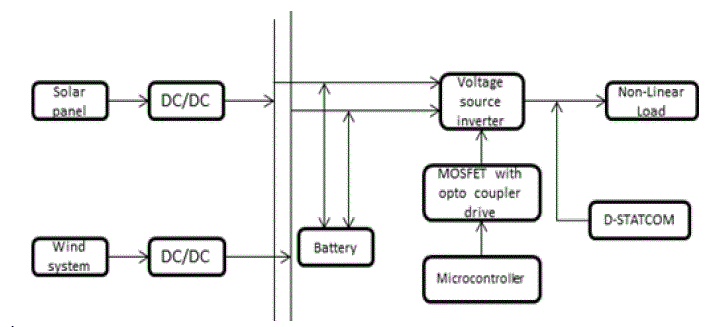 |
| B. System Operation |
| The Operation flow of the system is as follows. |
| • The Power generated by the Hybrid system is sent simultaneously to the voltage source inverter and the battery for the purpose of charging. |
| • The Battery charges and discharges depending on the amount of power required by the load. When the generated power is sufficient to supply the load, the battery just charges for it is required to supply the power by means of discharging when the generated power is insufficient to supply the load. |
| • The AC power obtained from the output terminals of the VSI is then supplied to the Non-Linear load after passing through the STATCOM for the purpose of reducing the harmonics produced in the current waveform due to the use of Non-linear load. |
SYSTEM COMPONENT MODELLING
|
| SOLAR CELL: The solar cell is a semiconductor and solid state device. It directly converts solar energy into electricity as done by the photovoltaic effect. The basic unit of photovoltaic system is the solar cell and it is made from various semiconductor materials such as silicon, cadmium, cadmium telluride, gallium arsenide etc. The solar cell generates voltage when sun light falls on it. The power obtained in day time is stored in solar batteries. The configuration of a solar cell is to form ap-n junction semiconductor. The charge distribution near the p-n junction gives rise to an electric field and hance a potential difference across the junction. If an external load is applied, this charge difference will drive a current through it. The current will flow so long as the sunlight keeps generating the electron pair. |
| This model is used to describe the electric behaviour of a solar cell. The equivalent circuit of solar cell consists of current source, single diode, shunt resistance and series resistance. The current source in the solar cell represents the photocurrent of the cell. The large number of solar cells are connected in series and grouped into a pv array. |
| The output power developed from the solar cell is given by |
| P = VI |
| Where V= Voltage produced in solar cell (V) |
| I = Current produced in solar cell (A) |
| WIND TURBINE: Wind is the air in motion and it is created as an effect of solar heat. The wind mill consists of wind turbine blades, drive shaft coupling and an electrical generator .In the proposed model the wind turbine is coupled with DC machine which is a DC generator. The wind power is developed with reference to variation of the air density, hub height and the position of the wind turbine in the sites by the use of which the force of wind has been exploited by wind mill. It consists of larger sized propeller blades connected to a DC machine. The turbine rotation mainly depends on the cut in and cut off speed. If the wind speed is below the reference speed, the turbine doesn’t rotate and if the wind speed is above the cut-in speed the wind turbine starts rotating. The power developed from the wind can be evaluated at a given wind speed through the power curve. |
| The output power generated by the wind turbine is given by |
| P = 0.5ρACpv3 watts Where V = wind speed in meter/second |
| ρ = Air density in Kg/m3 |
| A = cross sectional area in m2 |
| Cp is the power coefficient, it depends on the wind velocity and wind turbine and it is a ratio of power extracted by the turbine to the total contained in the wind resources. The power coefficient is a function of tip speed ratio (ÃÅ ÃŽ) and pitch angle (β). |
| Cp = PT /PW |
| The output torque of the wind turbine is given by |
| T = 1/2ρACpv2/λ λ= tip speed ratio |
| Tip speed ratio is the ratio of linear speed of the tip of blades to the rotational speed of the wind turbine. The tip speed ratio is given by |
| λ = RΩ/V R = Rotor radius, Ω= Mechanical angular velocity of the rotor. |
| BATTERY :Battery is generally used as a energy storage device. The primary goal of battery is to regulate the common DC-bus voltage. In hybrid power system mostly lead acid batteries are used. In the proposed system, VRL A battery is used as a backup device. The Battery is connected continuously to the power system. When the power generation is insufficient to supply the load, the battery supplies the power to the system. In case of sufficient power generation, the excess power is stored in battery. The modelling of lead acid battery consists of anode,cathode and an electrolyte. The lead is used as anode and lead dioxide is used as cathode, electrolyte used here is dil.H2SO4. Lead acid battery is a rechargeable battery and it is mainly used in cars, buses, telephone exchange, gas engine ignition,power station etc. The charging and discharging reactions are given below. |
 |
 |
| VOLTAGE SOURCE INVERTER:A Voltage Source Inverter is a power electronic device. The input DC voltage is made available across the load alternatively by controlling the conduction of the thyristor. This input DC voltage is converted into a square AC output voltage. The voltage source inverter uses switching devices such as GTOs, power Transistor, MOSFET, IGBT for employing gate signal. It is widely used in adjustable speed drives and it can also be used to reduce voltage drop and power quality issue problems. The rms output voltage is given by |
 |
| D –STATCOM :STATCOM is a Static Synchronous compensator which is used as a shunt compensating device for reducing reactive power compensation ,improve system steady state and transient stability. The configurationof STATCOM consists of voltage source inverter, dc capacitor, coupling transformer, signal generation and control circuit. It is used for both active and reactive power compensation. It is capable of both generating and absorbing reactive power. In this proposed system D-STATCOM is used as it is suitable for operation in low voltage and only the injection of reactive power is required in the transmission system. Its construction is similar to STATCOM, voltage source inverter is connected in parallel with a DC capacitor and it can control both voltage and current in transmission system. |
SIMULATION AND RESULT
|
| The Proposed System simulation takes into account the simulations of the Solar-Wind integrated system whose output Power quality is improved by the use of D-STATCOM, which is a FACTS device. Fig. depicts the simulation of Output voltage and current waveform of the Hybrid Solar-Wind system without the use of FACTS device. Fig. shows the simulation of output voltage and current waveform of Hybrid Solar-Wind system with the inclusion of FACTS device (D-STATCOM) in the circuit. |
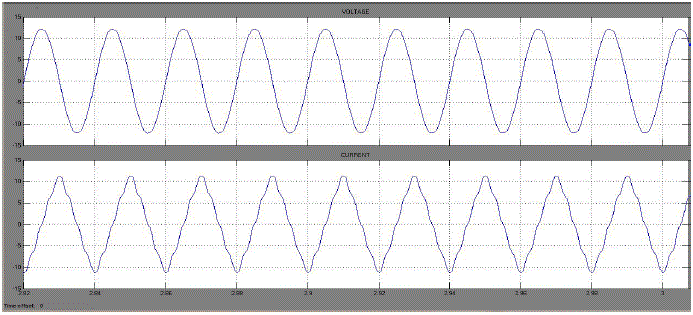 |
| Fig. 3 Output Voltage and Current waveform without the use of FACTS device |
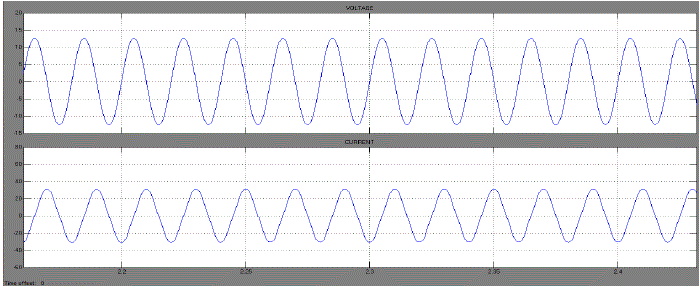 |
| Fig. 4 Output Voltage and Current waveform with the use of FACTS device |
| From the Fig. 3, it can be seen that the current waveform has a significant amount of harmonics without the use of FACTS device. The Fig. 4, which the simulation result of output voltage and current waveform with the use of FACTS device proves that the amount of harmonics in the current waveform has reduced significantly. |
| This can be justified by means of calculating the value of THD for both the cases as shown in the following figures. |
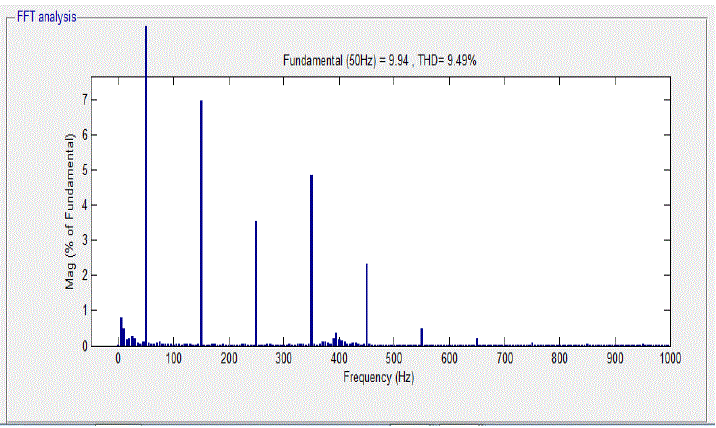 |
| Fig. 5 THD value of the output of the Hybrid System without FACTS device |
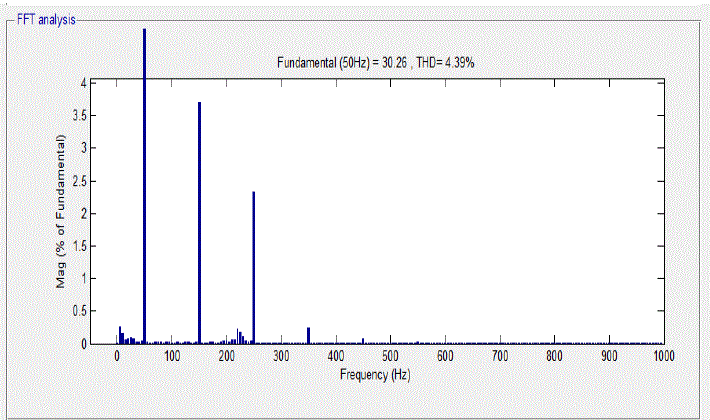 |
| Fig. 6 THD value of the output of the Hybrid System with FACTS device |
| It can be seen from the Fig. 5 & 6 that the value of THD has got reduced from 9.49% to 4.39%, thereby satisfying the standard set by IEEE (i.e) THD below 5%. |
| TABLE 1. SYSTEM SPECIFICATION |
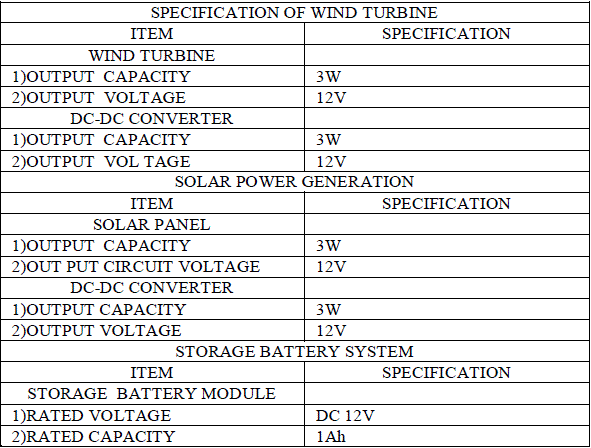 |
CONCLUSION
|
| This Paper has described a method of power quality improvement of Standalone Hybrid solar and wind power generation using FACTS deices. The main advantage of hybrid power generation is to provide the power to the isolated and rural areas. When we apply the non-linear load, the harmonics is produced in the form of Voltage and Current. By using FACTS devices, the harmonics are reduced. In this paper, we compare the simulation with using FACTS devices and without using FACTS devices. From the simulation results, it can be understood that the Total Harmonic Distortion rating was reduced to below 5% as per the IEEE standards.c |
References
|
- Belfkira.R ,Hajji.O ,Nichita.C , and Barakat.G, “Optimal sizing of stand-alone hybrid wind/pv system with battery storage,” in Proc.PowerElectron. Appl.Eur.Conf.,pp.1-10, Sep.2007.
- Kim.S.-K, Jeon.J.-H, Cho.C.-H., Ahn.J.-B, and Kwon .S.-H, “Dynamic modeling and control of a grid –connected hybrid generation systemwith versatile power transfer,” IEEE Trans.Ind.Electron., vol.55, no.4, pp.1677-1688,Apr.2008.
- Kobayashi.K, Matuso.H, and Sekine.Y, “Novel solar-cell power supply system using a multiple-input dc-dc converter,” IEEETrans.Ind.Electron.,vol.53,no.1,pp.281-286,Feb.2006.
- Kobayashi.K, Matuso.H, and Sekine.Y, “An excellent operating point tracker of the solar-cell power supply system,” IEEETrans.Ind.Electron.,vol.53,no.2,pp.495-499,Apr.2006.
- Liu.C, Chau.K.T, and Zhang.X, “An efficient wind-photovoltaic hydrid generation system using doubly excited permanent –magnet brushlessmachine,” IEEE Trans.Ind.Electron.,vol.57,no.3,pp 831-839,Mar.2010.
- Ming-Shun Lu, Chung-Liang Chang, Senior Member, IEEE and Wei-Jen Lee, Fellow, IEEE, and Li Wang, Senior Member, IEEE“Combiningthe Wind Power Generation System with Energy Storage Equipment”, IEEE Trans. Ind. Appl., Vol. 45, no. 6, pp 2109 – 2115, Nov- Dec-2009
- Toshiro Hirose and Hirofumi Matsuo, Fellow, IEEE ”Standalone Hybrid Wind-Solar Power Generation System Applying Dump Power ControlWithout Dump Load”, IEEE Trans. Ind. Electron., Vol. 59, no. 2, pp 988-997, Feb. 2012.
- Valenciaga.F and Puleston.P.F, “Supervisor control for a stand-alone hybrid generation system using wind and photovoltaic energy,” IEEETrans.Energy converter.,vol.20,no.2,pp 398-405,Jun.2005.
|